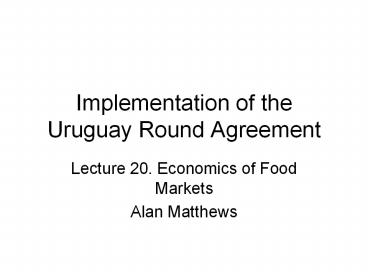Implementation of the Uruguay Round Agreement - PowerPoint PPT Presentation
Title:
Implementation of the Uruguay Round Agreement
Description:
Commitments entered into Schedules attached to the final WTO Agreements ... more active management of export refund system to stay within subsidised export targets ... – PowerPoint PPT presentation
Number of Views:543
Avg rating:3.0/5.0
Title: Implementation of the Uruguay Round Agreement
1
Implementation of the Uruguay Round Agreement
- Lecture 20. Economics of Food Markets
- Alan Matthews
2
The legal framework
- Commitments entered into Schedules attached to
the final WTO Agreements - Monitored by a WTO Committee on Agriculture which
meets every 6 months - Attempts to settle complaints should first be
made bilaterally, but countries have recourse to
the WTOs Dispute Settlement Mechanism
3
Market access
- Tariffication a major achievement
- Now 100 coverage of tariff bindings
4
Pre- and post-Uruguay Round scope of bindings for
agricultural products (Number of lines, billions
of US dollars and percentages)
x
ltgt
5
Market access how much liberalisation?
- Effectiveness of the agriculture agreement in
cutting protection was less impressive than the
nominal cuts suggest, because - tariff cuts took place from base levels that were
frequently inflated through the choice of base
year, - through the methods used to measure protection
existing prior to the round (dirty
tariffication), - Through use of unweighted average of 36
- through the use of ceiling bindings in
developing countries - Uneven tariff reduction many sensitive products
still protected by high tariffs - Minimum access commitments counted imports under
existing special arrangements, despite MFN
requirement
6
Tariff rate quotas
7
Reductions in Domestic Support to Agricultural
Producers (Millions of US dollars)
ltgt
8
Domestic support
- various types of supports excluded from the AMS
disciplines, e.g. de minimis, Blue Box, Green Box - AMS discipline established at an aggregate level,
not on a commodity by commodity basis.
9
Export subsidy reduction commitments by country
(Millions of US)
ltgt
10
Export subsidy commitments
- Front-loading
- Credit for unused commitments could be brought
forward to later year - Concerns about the behaviour of State Trading
Enterprises in agricultural marketing
1995
2000
11
Assessing the impact of the URAA
- overall gains in world welfare though of a
relatively small magnitude - Tangermann puzzle why so little change in OECD
PSE figures despite the mandated UR reductions? - Water in the bindings
- Distinction between implicit and explicit policy
change - UR established a framework for further
disciplines - UR framework is shaping domestic policy
discussions
12
Adjusting CAP to the URA
- What changes were necessary to the CAP
mechanisms? - the implementation of tariffication
- other market access provisions
- no real effect of AMS provision
- more active management of export refund system to
stay within subsidised export targets - Were the GATT disciplines consistent with the
MacSharry 1992 reforms?
13
(No Transcript)
14
Some specifics of CAP adaptation to WTO
disciplines
- Examples of how tariff for wheat was set
- Variable levy system retained for cereals and
fruits and vegetables - (Ab)use of special safeguard provision
- Removal of domestic support to Blue Box
- But export subsidy restrictions have had some
effect
15
Reading
- Tangermann two articles
- OECD 2001 report
- Ingco paper
- Swinbank and Tangermann articles on adaptation of
the CAP































